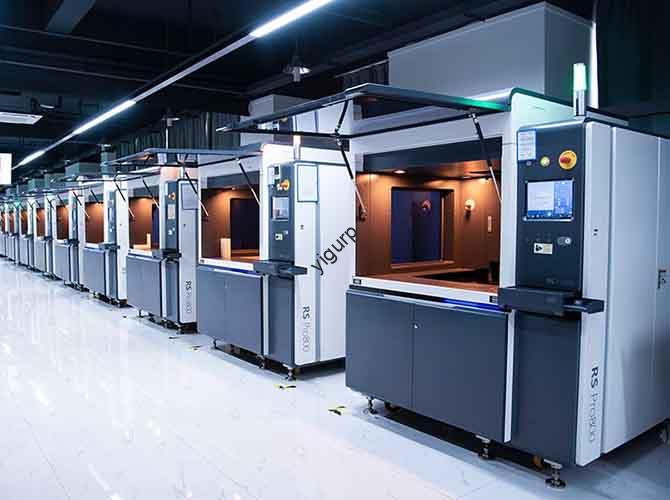Sind Sie es leid, schlicht zu sein?, monochrome 3D prints that fail to capture fine details or realistic colors? 3D printing color maps solve this problem by merging advanced 3D printing tech with precise color reproduction—turning digital designs into vibrant, dreidimensionale Objekte. This guide breaks down everything you need to know to leverage this technology effectively.
1. What Are 3D Printing Color Maps? Ein technischer Zusammenbruch
Im Kern, 3D printing color maps are processes that add color to 3D prints during production, Nicht nach. Unlike traditional 2D printing (which lays ink on flat surfaces), 3D color printing embeds color into every layer of the object—ensuring long-lasting vibrancy even on wearable or high-use parts.
Two Key Coloration Methods
| Verfahren | Wie es funktioniert | Schlüsselvorteil |
| Ink/Dye Infusion | Ink or dye is applied directly to the printed material as each layer forms. | Ideal for smooth, detaillierte Oberflächen (Z.B., figurines or medical models). |
| CMYK Material Mixing | Colored filaments (Cyan, Magenta, Yellow, Key/Black) are blended in precise ratios. | Achieves thousands of color combinations, including exact Pantone matches. |
Think of it like baking a cake: 2D printing is adding frosting on top, während 3D printing color maps are mixing food coloring into the batter—color runs through the entire product, not just the surface.
2. Why Choose 3D Printing Color Maps? 5 Unbeatable Benefits
For designers, Hersteller, und Pädagogen, 3D printing color maps eliminate common pain points of traditional 3D printing. So wie:
- No Extra Cost for Color: Generate colorful models directly from digital files—no need to budget for post-print painting or coloring.
- Zeit sparen: Skip manual coloring (which can take hours or days for complex parts) and get ready-to-use prototypes in hours.
- Durable Color: Color stays intact on high-wear areas (Z.B., toy parts or tool handles) because it’s embedded in the material.
- Precision Matching: Achieve accurate skin tones, brand colors (like Coca-Cola red), or Pantone shades—critical for medical or marketing projects.
- Designfreiheit: Create complex, multicolored details (Z.B., a 3D map with different colors for oceans, forests, and cities) that 2D prints can’t replicate.
3. Anwendungen in der Praxis: Where 3D Printing Color Maps Shine
3D printing color maps aren’t just for art—they’re transforming industries by solving unique problems. Below are three key use cases:
Fall 1: Medizinische Industrie
Doctors often struggle to explain complex injuries (like a fractured skull) to patients with plain models. Mit 3D printing color maps, they can create models where:
- Broken bones are highlighted in red.
- Healthy tissue is shown in pink.
- Surgical plans are marked in blue.
This makes diagnosis and treatment discussions 50% more intuitive, nach a 2023 study by the Journal of Medical Imaging.
Fall 2: Ausbildung
Teaching geology? A 3D-printed color map of the Earth’s crust can show:
- Mantle (orange)
- Outer core (Rot)
- Inner core (Gelb)
Students retain 3x more information when using these tactile, colored models compared to 2D textbooks (National Education Association, 2024).
Fall 3: Kunst & Design
Artists can now replicate famous sculptures (Z.B., Michelangelo’s David) mit:
- Realistic skin tones
- Colored clothing details
- Even weathered textures
Museums use these prints to let visitors touch art without damaging the original.
4. Zukünftige Trends: What’s Next for 3D Printing Color Maps?
The technology is evolving fast—here’s what to expect in the next 3–5 years:
| Trend | Auswirkungen | Zeitleiste |
| Niedrigere Kosten | Entry-level 3D color printers will drop from \(5,000 Zu \)1,500, making them accessible to small businesses. | 2025–2026 |
| Neue Materialien | Heat-resistant and flexible colored filaments will enable use in aerospace (Z.B., colored engine parts) and fashion (Z.B., 3D-printed shoes). | 2026–2027 |
| AI Integration | AI will auto-adjust color ratios for perfect matches, Reduzierung menschlicher Fehler durch 70%. | 2024–2025 |
Imagine this: Von 2027, a small jewelry designer could 3D-print a custom necklace with the exact color of a customer’s favorite flower—all in under an hour, for less than $50. That’s the power of advancing 3D printing color maps.
5. Perspektive der Yigu -Technologie
Bei Yigu Technology, Wir glauben 3D printing color maps are the future of personalized manufacturing. Our team has tested this technology with clients in medical and education—seeing firsthand how it cuts production time by 40% and improves user engagement. We’re investing in AI-driven color calibration tools to make 3D color printing even more accessible. Für Unternehmen, now is the time to adopt this tech: it’s no longer a “nice-to-have” but a “must-have” to stay competitive.
FAQ
- Q: Can 3D printing color maps match any Pantone color?
A: Ja! Using CMYK material mixing, most 3D color printers can match over 90% von Pantone-Farbtönen – perfekt für markenspezifische Projekte.
- Q: Sind 3D-gedruckte Farbobjekte langlebig??
A: Absolut. Denn Farbe ist im Material verankert (not just the surface), Diese Objekte sind lichtbeständig, Kratzen, und Abnutzung – auch bei regelmäßiger Nutzung.
- Q: Benötige ich eine spezielle Software, um Farbkarten für den 3D-Druck zu erstellen??
A: Die meisten Standard-3D-Designtools (Z.B., Mixer, Fusion 360) Unterstützt jetzt die Farbzuordnung. Für einfachere Farbanpassungen können Sie auch spezielle Tools wie PrusaSlicer verwenden.
